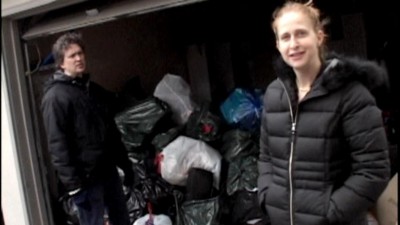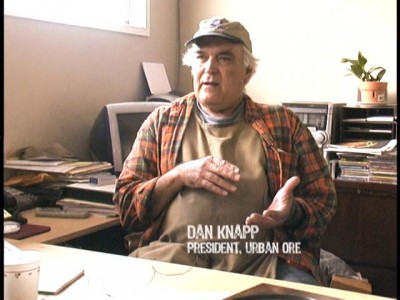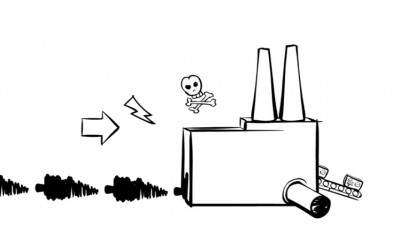| Reviews & Columns |
|
Reviews DVD TV on DVD Blu-ray 4K UHD International DVDs In Theaters Reviews by Studio Video Games Features Collector Series DVDs Easter Egg Database Interviews DVD Talk Radio Feature Articles Columns Anime Talk DVD Savant Horror DVDs The M.O.D. Squad Art House HD Talk Silent DVD
|
DVD Talk Forum |
|
|
| Resources |
|
DVD Price Search Customer Service #'s RCE Info Links |
|
Columns
|
|
|
Garbage! The Revolution Starts at Home
Ironweed Film Club // Unrated // April 1, 2009
List Price: $19.95 [Buy now and save at Ironweedfilms]
The Films:
Ironweed is a publisher that releases a DVD per month to the members of their film club (much like Film Movement does.) Each of their releases is filled with movies and shorts by independent filmmakers that follow a theme. The first of their releases that I've had a chance to screen is #41, Garbage! The Revolution Starts at Home. Containing a feature and two shorts (that together run nearly an hour) this set of documentaries looks at our consumer society, and specifically how much waste we generate. All three of the films are thought provoking and are sure to start discussions. Though they are generally very good at explaining and illustrating the problems, it was a little disappointing that all of the entries on this disc were short on solutions.
Garbage! The Revolution Starts at Home (76 minutes): Filmmaker Andrew Nisker, worried about what the world would be like when his young son became an adult, decided to find someone who would be willing to keep all of their garbage for three months to see just how much waste we generate. He premise, and it's a good one, is that we really don't realize how much garbage we throw away because someone comes around once a week to whisk it away. He started by spending a couple of days in front of a supermarket looking for a volunteer. When that didn't work he approached his best friend... well, actually his best friend's wife. After talking her into the crazy idea, she went to work on her husband and the McDonald's became the guinea pigs.

They planned on putting all of their garbage into large, black contractor plastic bags and store it in their garage. The recycling would be placed in similar sized clear bags, and the material that qualified for their area's composting recycle bins would be weighed and then removed each week (for health concerns.) Luckily the family lived in
While the McDonalds were bringing home their trash from the birthday parties the kids were invited to, the director would take side trips to landfills, recycling plants, and coal mines to see just where the products that the McDonalds were using came from and where they ended up.
Nisker didn't just look at the refuse we generate as consumers, he also talked about pollution caused by cars, how over-packaged most products are, and the affect on the environment that energy generation inflicts. He also sprinkles some interesting facts through the documentary that are intentionally supposed to raise eyebrows.
While this is a very interesting experiment, one that I'd never willingly participate in, and it illustrated how away the McDonald's became about the products they bought and the waste they generated, there were some flaws. The biggest one is that there are few solutions given, and in some cases the film all but states that there is nothing to be done in some circumstances. When the McDonalds go to the grocery store they discover that a lot of the products they need come with excess packaging. Even the variety of oranges they purchase come in a crate.

Nisker painted such a dire picture at times that the film was counter productive to some extent. When they state, for example, that 1 trillion plastic bags are used in the world every five minutes, it's hard to see I'm making any difference when I take reusable burlap bags to the grocery store.
Even with these defects the movie was engaging and interesting. The worst flaw was Nisker has an irritating style. The production would have been greatly improved if the director invested in a steady cam, or even just a tripod. As it is most of the interviews employ a hand held camera that's jerky and often cuts off the heads of the people who are talking. At one point the Nisker goes to a junk yard to have his old vehicle recycled. He was attached to his old Jeep, so the operator allows him to press the button to start the crusher, but he holds the button up off camera, missing the shot. It would have been easy to retake the shot and mimicked pressing the button, but they didn't. It is things like that that scream "amateur!" when watching this film, and that's too bad because the film is actually much better than that. There was a lot of thought and organization that went into the production and sloppy camera work shouldn't take away from that.
The Recyclergy (33 minutes): This is a nice, fairly amusing piece that profiles several trash hounds in San Fransisco who started their own recycling businesses. They tell amusing stories about how the municipal dump won't allow you to take garbage away, and relate some of the more interesting finds they've had. The people interviewed are all colorful characters and it's clear that they enjoy what they're doing. The most impressive part is when they show a big guy who goes by Hulkster segregating glass by color. He throws bottles into sorted dumpsters faster than you could drop them on the ground. Entertaining and fun.

The Story of Stuff (20 minutes): This was both the most simple, and clear cut explanation of the problems of mass consumerism, and the most irritating. An animated piece, save for the on-screen narration by writer/filmmaker Annie Leonard, this film illustrates the life cycle of 'stuff'. Leonard shows how currently the objects are manufactured from raw materials, sent to retailers, bought, and then disposed of, and that there is a huge amount of waste at every step of the way. Elegantly simple in her presentation it is a shame that the piece is filled with emotion-laden words that will turn off many viewers. For example, she states that during production "we use energy to mix toxic chemicals in with the natural resources to make toxic, contaminated products." Basically she is saying that all production is bad. Funny, she never mentions the toxic chemicals and heavy metals used in the film stock she employed. But I'm sure that's fine since she's using it for a good purpose. Don't get me started on her rant against "synthetic chemicals" as if the fact that it was made in a lab made it inherently dangerous. Cobra venom is a natural chemical but I'd rather have Brominated flame retardants in my things than that a neurotoxin.

This film also makes some false and dubious claims. While discussing planned obsolescence, the idea that some products are made of cheap materials so that they will fail after a certain amount of time and have to be discarded and replaced, she uses DVDs as an example. What?!!? I've been collecting DVDs for ten years and have over 5000 currently and only two of them have ever failed to play. That's just an out and out false claim. She also states that out of all of the products sold in

The reason these falsehoods, exaggerated claims, and simple-minded solutions are so irritating is because without them she would have a very good film. Leonard does a great job presenting the problems and explaining why they exist, and this understanding is the first step towards convincing people that they need to change.
The DVD:
Audio:
All three of these documentaries come with a two-channel soundtrack. None of them were really exciting. There was some slight distortion in the first short, but aside from that the audio was anchored on the screen and sounded fine.
Video:
I was pleased to see that two of the films on this disc were presented with an anamorphic 1.78:1 image (The Recyclergy is full frame) and they all looked about average for low budget independent films. The feature and first short had the white levels too high in some scenes leading to some blooming, and Aliasing was a problem with them too. Aside from that things looked fine, though nothing to write home about.
Extras:
Aside from a trailer for the Iron Weed Film Club and a text piece about the organization "Art from Scrap" there were no extras.
Final Thoughts:
This was a very nice set of films. While I enjoyed the short The Recyclergy the most, the other two had some interesting points to make and will certainly lead to lively discussions. I only wish they had spent more time on outlining courses of action that people could take to help the problem. I assume the reason that they didn't is because in the end it all comes down, as many things do, to money. When the garbage man starts weighing your waste and charging you $20 per pound to haul it away, people will start demanding less packaging in the things they buy and not be so quick to discard something that could be repaired. Until that day comes though, I think people in first world countries will continue down the same path. In any case, this is a very nice disc and comes recommended.
|
| Popular Reviews |
| Sponsored Links |
|
|
| Sponsored Links |
|
|
| Release List | Reviews | Shop | Newsletter | Forum | DVD Giveaways | Blu-Ray | Advertise |
|
Copyright 2024 DVDTalk.com All Rights Reserved. Legal Info, Privacy Policy, Terms of Use,
Manage Preferences,
Your Privacy Choices | |||||||













